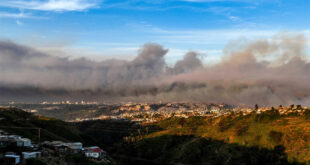China warned that severe drought conditions along the Yangtze river could last well into September as local governments race to maintain power and find fresh water supplies to irrigate crops ahead of the autumn harvest.
While flooding caused by heavy rainfall in the western Chinese province of Qinghai has killed 16 people, state media reported on Thursday, with an additional 36 missing.
A severe heatwave across the basin of China’s longest river, the Yangtze, caused by a larger than usual Western Pacific subtropical high, has now lasted more than two months, slashing hydropower supplies and drying out large expanses of arable land.
In the sprawling southwestern region of Chongqing, where most of Yangtze’s Three Gorges reservoir is located, the grid is now scrambling to secure electricity from other parts of the country as supplies to industrial consumers are rationed, state media reported.
China’s State Grid also promised to do its utmost to dispatch power to neighbouring Sichuan province, which normally supplies large amounts of surplus hydroelectricity to the eastern coast but is now imposing strict consumption controls.
Normal water flows in the region could still be months away, with rainfall expected to remain low until the end of this month and beyond, said Liu Zhiyu, an official at the Ministry of Water Resources, speaking at a briefing on Wednesday.
“It is expected that in September, water inflows in the middle and lower reaches of the Yangtze will still be low, and the drought in Anhui, Hubei, Hunan and Jiangxi could develop further,” Liu warned, referring to four major provinces on the middle reaches of the river.
Rainfall in the Yangtze basin has been around 45% lower than normal since July, and high temperatures are likely to persist for at least another week, official forecasts said.
Authorities in the region also warned that temperatures would continue to exceed 40 degrees Celsius (104 Fahrenheit) on Thursday, with parts of Chongqing set to go beyond 44 degrees, putting further pressure on power supplies amid surging air conditioner use.
Water levels on the main trunk of the Yangtze and the vital flood basin lakes of Dongting and Poyang are now at least 4.85 metres (16 feet) shallower than normal, and the lowest on record for the period, officials said.
The Yangtze’s maritime safety bureau has issued several warnings about low water levels, ordering vessels to reduce their load when passing through shallower parts of the river.
Freight rates for coal delivery along the river rose 8% last week because of reduced shipping capacity.
‘Critical period’
Controlling water resources is seen as a crucial part of government in China as it tries to guarantee food supplies and secure another bumper harvest.
Rice and other autumn crops were now at a “critical period” when it comes to irrigation, warned Liu Weiping, Vice-Minister of Water Resources, at the same Wednesday briefing.
He said around 820,000 hectares (2 million acres) of arable land from Sichuan in the southwest to central China’s Anhui have suffered damage, affecting 830,000 people as well as 160,000 head of livestock.
The drought has also highlighted the role played by the cascade of giant hydropower projects in regulating flows on the Yangtze, which supports around a third of China’s population.
Giant upstream reservoirs like Xiluodu and Xiangjiaba have opened their gates to replenish storage levels at the Three Gorges Dam, which will release 830 million cubic metres downstream over the coming days, Liu said.
Reservoirs along the Yangtze have already released an additional 5.3 billion cubic metres of water since the start of August.
- Reduce Hair Loss with PURA D’OR Gold Label Shampoo
- Castor Oil Has Made a “Huge” Difference With Hair and Brow Growth
- Excessive hair loss in men: Signs of illness that cannot be subjective
- Dịch Vụ SEO Website ở Los Angeles, CA: đưa trang web doanh nghiệp bạn lên top Google
- Nails Salon Sierra Madre
 VnExpress News The News Gateway of Vietnam
VnExpress News The News Gateway of Vietnam




